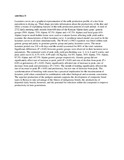Characteristics of Lactation Curves of the Kenya Alpine Dairy Goats in Smallholder Farms

Date
2014Author
Gitahi Marete, Andrew
Oyoo Mosi, Reuben
Oluoch Amimo, Joshua
Owino Jung’a, Joseph
Type
ThesisLanguage
enMetadata
Show full item recordAbstract
Lactation curves are a graphical representation of the milk production profile of a doe from parturition to drying up. Their shape provides information about the productivity of the doe and offers a means of explaining features of the milk production patterns of each animal. A total of 2732 daily morning milk records from 610 does of the Kenyan Alpine dairy goats’ genetic groups (50% Alpine, 75% Alpine, 87.5% Alpine and > 87.5% Alpine) and local goats (0% Alpine) kept in small-holder farms were used to evaluate factors affecting milk yield and to examine the characteristics of their lactation curve. A nonlinear mixed model was used to fit the lactation curves to all does simultaneously. The Wood’s (1967) equation was fitted within each genetic group and parity to generate genetic group and parity lactation curves. The mean lactation period was 218 ± 46 days and the model accounted for 88% of the total variation. Significant differences (P < 0.05) between genetic groups were observed in their lactation curve parameters. The estimated week of peak milk yield post kidding was: 2, 4, 6, 6 and 8 weeks; and peak yield was 0.32, 0.75, 0.91, 0.99 and 1.02 Kg/day, for 0% Alpine, 50% Alpine, 75% Alpine, 87.5% Alpine and >87.5% Alpine genetic groups respectively. Genetic group did not significantly affect rate of increase to peak yield (P > 0.05) and rate of decline from peak (P > 0.05) or persistency (P > 0.05). Parity significantly affected rate of increase to peak, rate of decrease from peak and persistency (P < 0.01). The month of kidding significantly affected the rate of increase to peak (P < 0.05) and persistency, but not rate of decrease from peak. The synchronization of breeding with season has a practical implication for the maximization of lactation yield when considered in combination with other biological and economic constraints. The superior production of the pedigree animals supports the development of composite breed types in Kenya to take advantage of the fitness of indigenous breeds, the productivity of imported dairy breeds, heterosis, and the potential for selection within the composite to improve productivity in later generations.
URI
http://www.scirp.org/journal/PaperInformation.aspx?paperID=44835#.U6wD4bEhMx8http://hdl.handle.net/11295/71160
Citation
Journal Biomedical & Life Sciences OJAS> Vol.4 No.2, April 2014Publisher
University of Nairobi
